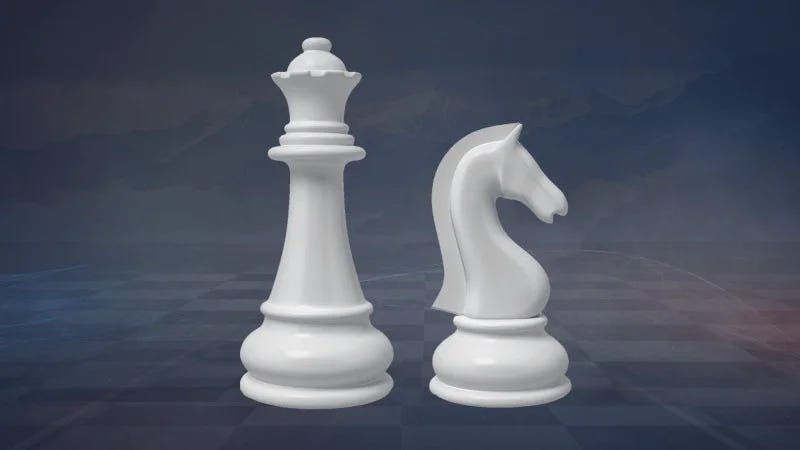
In this tale, set in a mystical realm, a wise and empowered Queen presides over a majestic and thriving kingdom. She possesses deep insight into the cycles of life, guiding her people with wisdom and compassion. However, as her realm grows and becomes more complex, the Queen realizes the need for assistance in managing its affairs.
She selects a humble and loyal Knight, who, despite lacking the Queen’s profound understanding of relatedness, possesses tremendous courage, practical skills and keen instincts. The Knight becomes the Queen’s trusted advisor and emissary, responsible for carrying out her directives and maintaining order within the kingdom.
Over time, the Knight’s role expands, and he gains influence and respect among the people. Yet, he remains steadfast in his loyalty to the Queen, always deferring to her wisdom and guidance.
Together, the Queen and her Knight navigate the challenges and complexities of ruling their kingdom, each contributing their unique strengths and skills to ensure its prosperity and well-being. Their partnership symbolizes the harmonious balance between intuition and practicality, wisdom and action, in the governance of their realm.
Together they embody “both the vision that reveals separation and the vision that reveals union.”
This story is my revision of the fable "The Master and His Emissary," wherein the Emissary, upon experiencing power and authority, forsakes his loyalty to the Master and seizes control over the kingdom. Author and psychiatrist, Iain McGilchrist, employs this fable as a metaphor for how the left hemisphere of the brain has deviated from its proper place in the psyche to take center stage, only to remove itself from its vital connection with the right hemisphere's capacity for perceiving the interconnectedness of reality.
David McIlory, in Understanding Iain McGilchrist's Worldview summarizes our problem this way:
"McGilchrist’s argument is that healthy individuals, groups, and societies approach the world first via the right hemisphere, reacting to what is found there to form an impression of how everything links together; then the left hemisphere looks in detail at elements that can become objects of human action in isolation, and then the results of the left hemisphere’s inspection are returned to the right hemisphere where the individual elements are reintegrated into a more profound understanding of the whole.”
“In unhealthy individuals, groups, and societies, the move to isolate and manipulate is the primary move, and the left hemisphere creates a feedback loop that fails to acknowledge the reality of that which can be embraced but cannot be grasped, that which must be accepted but cannot be captured in words.[3]"
I have written several articles envisioning the prioritizing of the mature feminine spirit, that is, valuing relatedness at least as much as decisiveness, as a new way of organizing ourselves, both individually and in groups (here and here). What McGilchrist refers to as the right hemispheric, broad attention, I intuit as the "feminine spirit," and the left hemispheric, narrow focus, I sense as the "masculine spirit." While there is evidence in our reproductive differences for the origin of these different ways of being, we would all probably be better off if we aimed to cultivate the ability to attend to both in such a way that brings us into greater alignment with reality.
In The Matter with Things, McGilchrist’s describes this harmony as:
“all that is to be known must initially ‘presence’ to the right hemisphere (we have no other access); then be transferred to the left hemisphere so as to gain expression through re-presentation; and that re-presentation returned to the right hemisphere where it is either recognised for its consonance with the initial presencing and subsumed into a new Gestalt, or rejected.”
Jonathan Rowson has coined this dynamic as The McGilchrist Manoeuvre:
“The McGilchrist Manoeuvre entails the combined perceptual and conceptual capacity that transcends contradictions, disclosing the coincidence of opposites as generative of reality, thereby re-enchanting aspects of life long considered problematic, including tension and paradox.”
In my recent article “Beyond Nihilism”, I explain how my daily, long-distance running ritual cultivates this Manoeuvre and how doing so brings me closer to the Sacred. I am curious what you do to cultivate this form of integrated attention. Feel free to share in comments below.



Another really good entry, thanks Claudia _/|\_
BTW I thought you might find this of interest and another potential entry point for "finding [the] others" interested in/ exploring similar territory.
https://emergent-commons.mn.co/posts/50175788
Love your retelling of the fable, a happy ending! I definitely see the union and separation as a delightful paradox and a dance of feedback and integration. Thanks!